

We may earn revenue from the products available on this page and participate in affiliate programs. Learn More ›
Your front porch is the first thing guests see when they walk up to your home. Along with your landscaping, it’s also one of the features of your home that will increase your curb appeal when neighbors drive or walk by. If you aren’t happy with the impression your porch is making and want to find some inspiring front porch ideas, it’s never too late to plan a porch makeover.
Read on to see how a few small modifications or additions to your front porch—or perhaps a larger-scale change—can help breathe new life into your space and make it the envy of the neighborhood.
RELATED: 9 Things to Know Before You Screen In a Porch
1. Peaceful Veranda

Convert your home’s wrap-around porch to a quiet and relaxing veranda with a few simple additions. Wicker rocking chairs offer a comfortable spot to sit back and relax, and a small table can hold drinks, snacks, books, and other essentials to ensure you have everything they need close at hand. With just a few additional decor touches—such as some hanging greenery or a flag—the space will be complete and ready to enjoy.
2. Floral Beauty
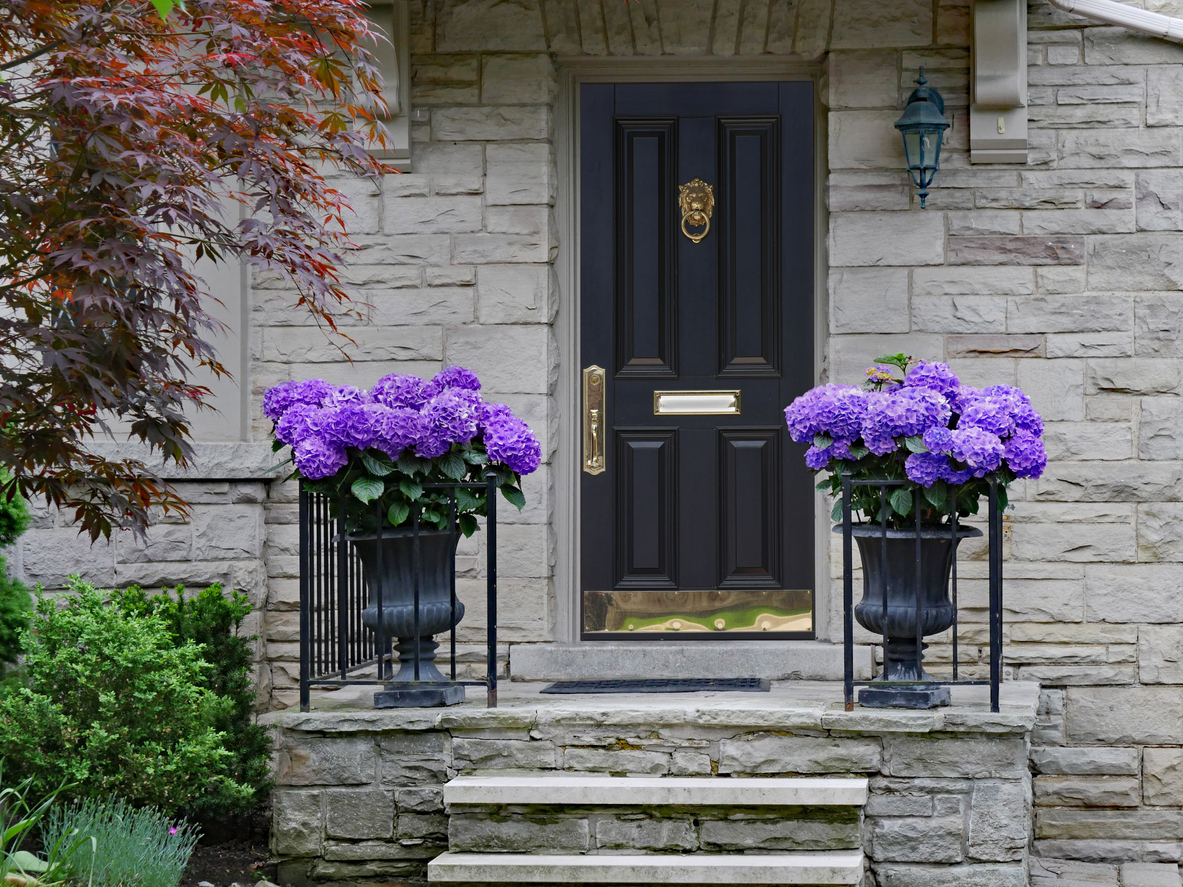
Just because you’re looking for small front porch ideas doesn’t mean you can’t make a big impact. Add large planters with vibrantly-colored hydrangeas or other flowers on either side of the porch for a quick and easy, yet striking, change. A fresh coat of paint on the door along with new hardware and a new kickplate can further enhance the look.
3. Coordinating Rug

Outdoor seating can certainly elevate your front porch, but go one step further by adding an outdoor rug to really pull the whole look together. A neutral outdoor rug with a durable and weather-resistant design—such as the nuLOOM Wynn Braided Indoor/Outdoor Area Rug—will coordinate nicely with your porch’s various materials and encourage guests to kick back and relax.
4. Colorful Plants and Flowers

Hanging planters and over-the-railing planting boxes can make excellent front porch decor. If you have a green thumb and want to show off some of your favorite plants and flowers, there’s no better place to showcase their beauty than on the front porch to welcome guests and catch the eye of passersby.
5. Modern Marvel

On the hunt for modern front porch ideas? Adding an industrial waterfall feature to your exterior entryway will not only turn heads, but the sound of the water cascading down will turn the walkway into a relaxing retreat. Complete this modern look with a double glass door and hanging porch light.
6. Swing into Comfort

If you have a covered porch but few covered porch ideas, why not hang a porch swing where you can sit and catch up on the morning’s news or unwind after a long day at work? The Wrenn Porch Swing from Birch Lane features a solid mahogany wood frame with a slatted back and curved arms—combine that with the comfortable cushion, and you’ll have the best seat in the neighborhood. Alternatively, if you love DIY projects, consider downloading a set of porch swing plans and building your own.
7. Columns and Recessed Lighting
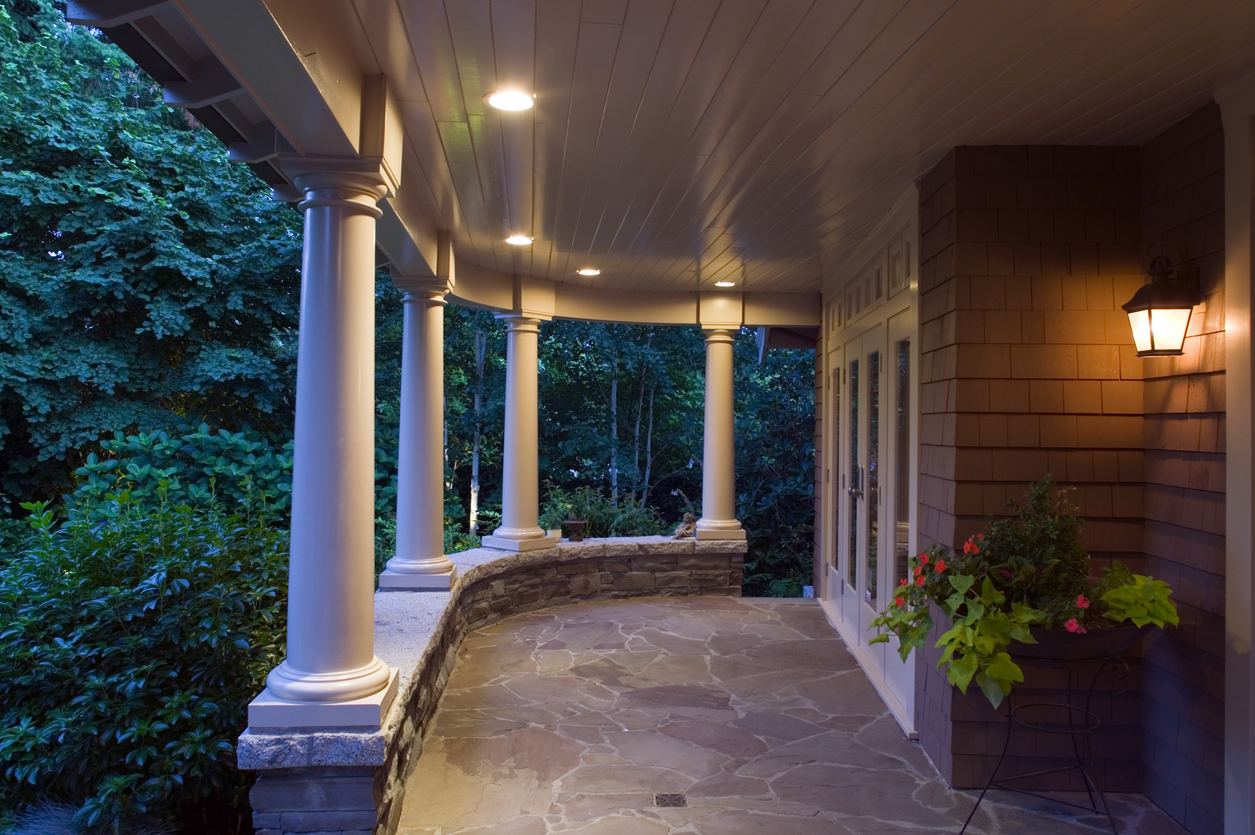
Another top covered porch idea is to add some recessed lighting to brighten the space, making it more suitable for evening entertaining or relaxing. Building columns into your covered porch can also add a touch of elegance and grandeur. With the main elements in place, finish up the look with stone flooring and some greenery.
RELATED: 10 Porch Colors That May Inspire You to Paint Yours
8. Bright Front Door

Repainting your drab or neutral front door in a bright and cheery color is one way to give your front porch an easy makeover. A fresh coat of paint will help breathe new life into the porch, and choosing a bright color will draw positive attention to the space. Meanwhile, a vintage seating arrangement will give your exterior some old-world European charm.
9. New Lighting
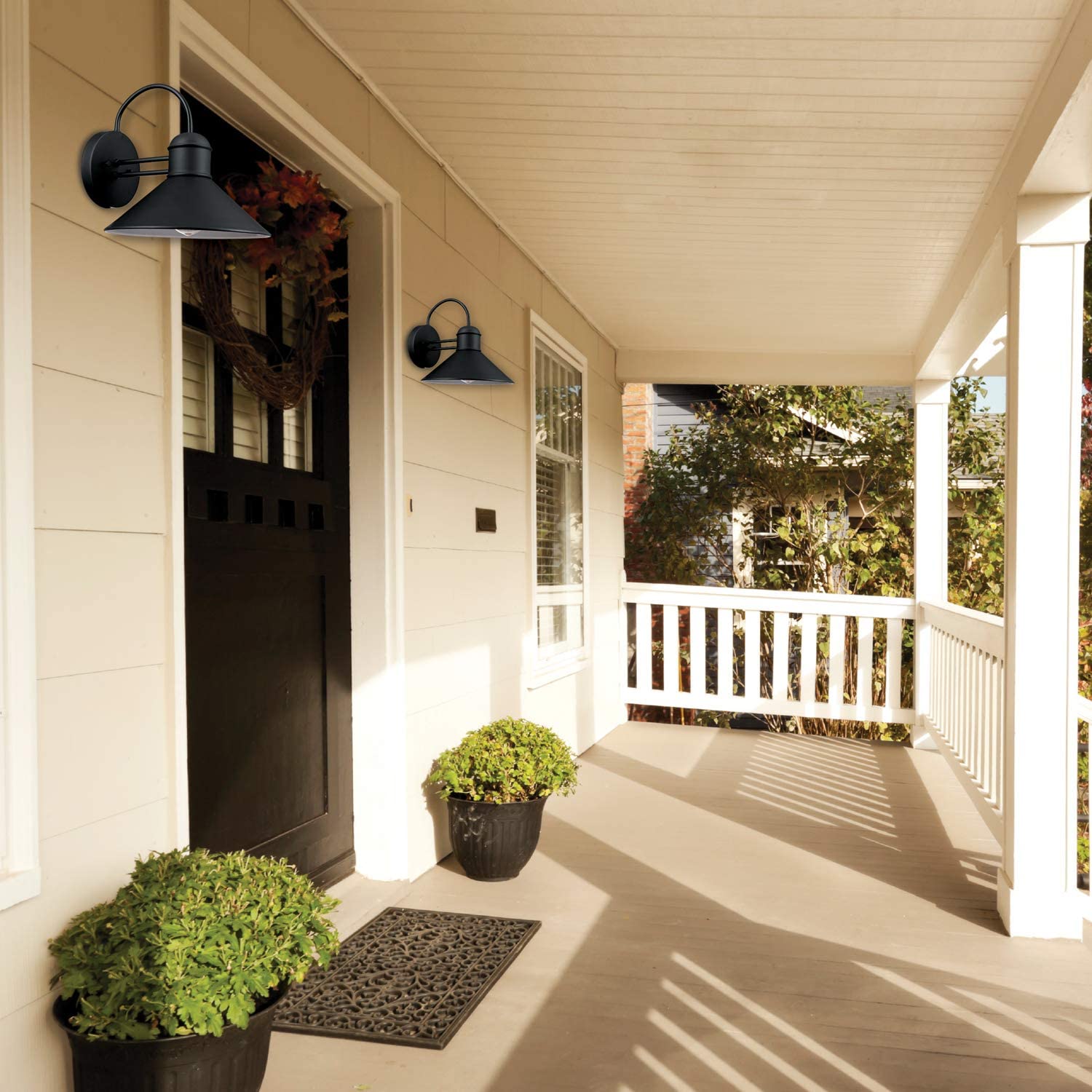
Upgrading old outdoor wall lights may seem like a small change, but it can make a huge difference for your front porch. These wall sconces from Globe Electric offer clean lines with a sleek black finish. Pairing these dimmable lights with a freshly painted front door and a new welcome mat can help you create a modern front porch look.
10. Welcome Spring

You don’t have to spend a lot of money to update your front porch’s decor to match the changing seasons. When thinking about small front porch ideas on a budget, think about ways to repurpose many of the items you already have in your home. For example, during the spring, use an old pair of rubber boots filled with flowers as a door wreath and old hoses to wrap the bases of decorative trees along either side of the door.
11. Rock On

Elevate the design of your front porch with a few simple—but purposeful—additions. Stylish outdoor rocking chairs—such as these Red Barrel Studio Broadfoot Rocking Chairs—paired with a small outdoor table to hold drinks and other essentials can create a comfy and cozy seating area. Additionally, a colorful outdoor rug and some plants will go a long way to pull the look together.
12. Clean and Green

Your front porch doesn’t need to be swimming in decor to offer a warm welcome to those who stop by. With a few potted plants, a large outdoor doormat, and a bench or chair, you can give others a wonderful first impression of your home and hospitality.
13. Halloween Ready

In fall, small front porch ideas can inject some spooky spirit into your entryway with Halloween-themed decor. Line the edge of your steps with some spooky or cheerful carved pumpkins, wrap leaves around columns and railings, and decorate your door with a creepy jack-o’-lantern-style face.
14. Modern Porch Swing

Adding a porch swing is another great option whether you’re looking for open or enclosed porch ideas. The Hampton Bay Gray Wicker Outdoor Patio Lounge Chair is an egg-shaped modern swing that adds both style and comfort to outdoor spaces with its unique design and water-resistant cushions. Finish up the space with plants, curtains, and even a candle or two for evening mood lighting.
15. Room for Two

Refreshing your furniture is one budget-friendly way to revive your porch. Add a small bistro set or a pair of Adirondack chairs to the side of your porch to create a cozy nook to enjoy a conversation with a friend or share an intimate meal with someone special. Enhancing your landscaping with some gorgeous flowering bushes can make the spot even more inviting by providing some bright colors for all to enjoy.
16. Secure Package Delivery

Your front porch does more than welcome visitors, also serving as the drop-off location for important packages and purchases. When you’re not home during the day, leaving these potentially valuable items out in the open could invite package thieves. With the Keter Secure Package Delivery, delivery drivers can deposit your parcels into the drop box, keeping them out of sight until you’re home to bring them inside.
17. White Lights

If you need front porch decorating ideas for the holidays, consider a simple and sophisticated look by hanging white string lights. Wrap the light around any columns along your porch and hang them over the gutter line to show your holiday spirit and create a warm entrance to your home. If desired, additional lighting can be hung on bushes or trees close to your front porch.
RELATED: 19 Ways to Make Your Front Porch More Inviting in Winter
18. Welcome Home
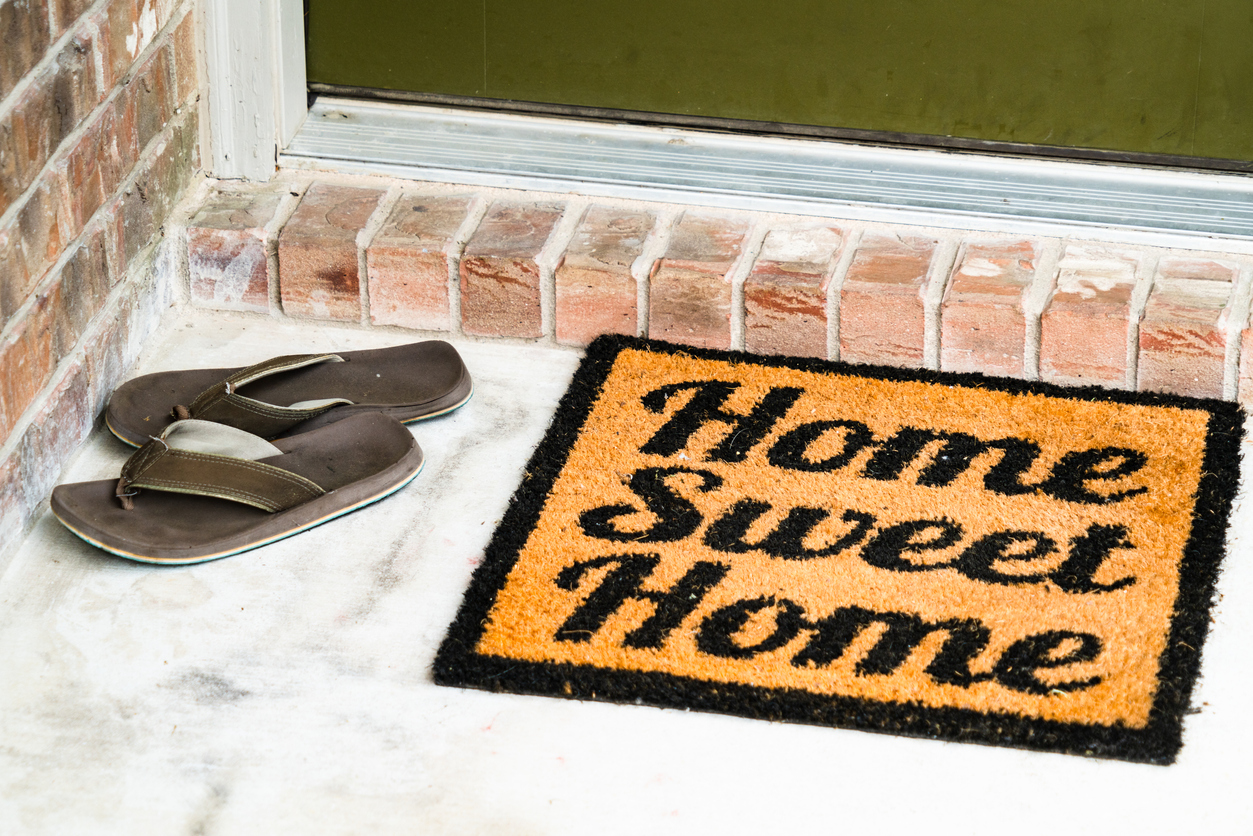
Beautifying your front porch can be as simple as adding a new welcome mat. With all the various sizes and designs available, you can find the perfect fit for your porch and your decor preferences. Moreover, there are a wide range of fun options available for welcome mats, from warm greetings to funny messages that give guests a peek at your personality.
19. Proud and Patriotic

Proudly display your love of the USA by hanging these bunting flags along your porch. These durable bunting flags are perfect for Independence Day, Memorial Day, Labor Day, or any day that you feel proud to be an American. The durable polyester material is designed to be long-lasting, allowing you to enjoy these flags for quite some time.
20. Retractable Awning

Installing a retractable awning is another way to help create your own personal oasis—with a touch of retro flair. A retractable awning can deliver cool shade that will make sitting out on the patio more pleasant on a warm day, and it can be easily put away on cool days, for storms, or when not in use. Don’t forget to add some comfortable seating so you can enjoy your newly renovated space.
21. Cool Breeze
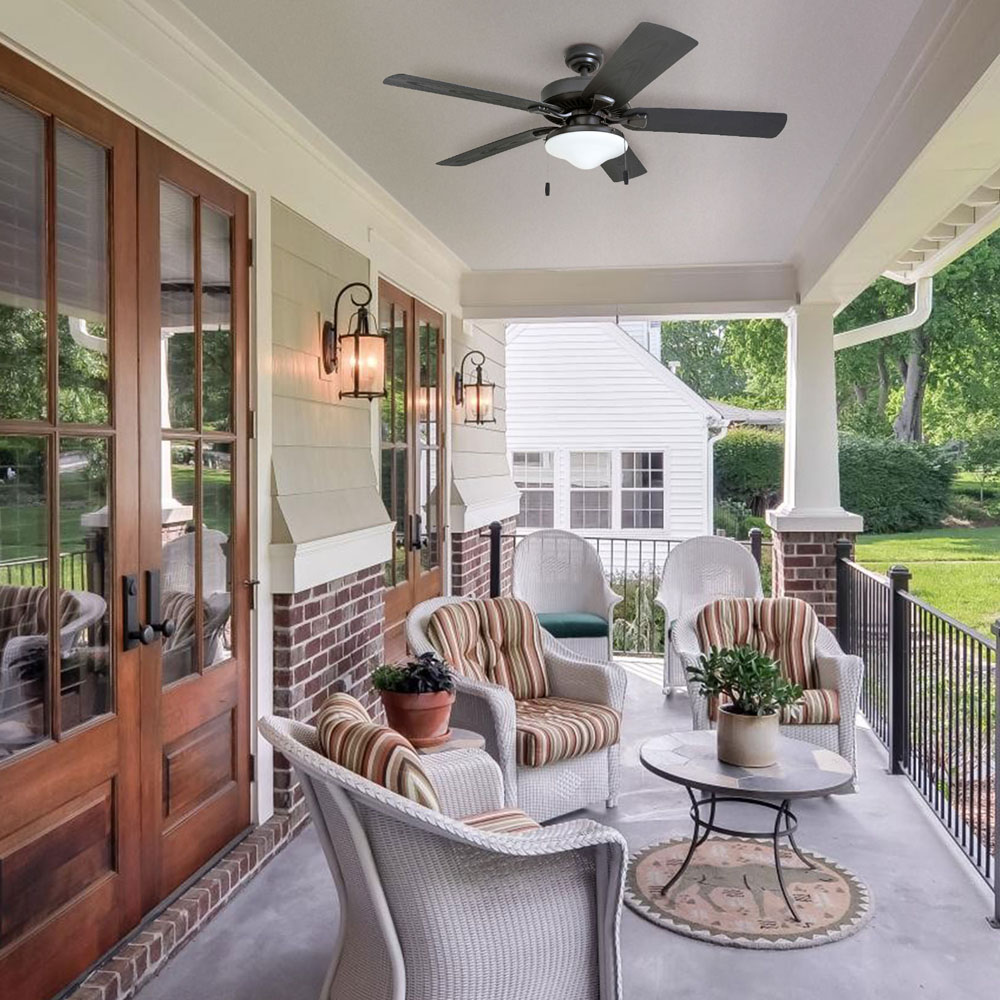
If you’re in need of porch ceiling ideas, consider adding an outdoor ceiling fan like the Honeywell Belmar 52-Inch Bronze Ceiling Fan to deliver a cooling breeze to your porch. This five-blade fan offers a traditional design, a frosted glass bowl with LED lights, and weather-resistant blades. The damp-rated fan is suitable for use on porches or other areas with higher moisture levels, as long as it is protected from direct rainfall.
RELATED: 22 Transformational Front Porch Ideas Your Neighbors Will Want to Copy
22. Safe and Sound

Coming home to a dark house and a dark porch is no fun and can potentially be unsafe. Installing a motion-sensing light above your door can help ensure that you can easily find your keys and get into your house when you get home. A motion-sensing light could also discourage a potential intruder from trying to break into your home.
